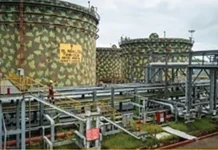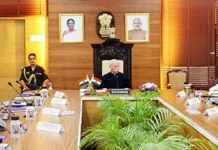[Prem Taba]
The Papu-Yupia junction in the Itanagar Capital Region (ICR) has become a perennial headache for commuters due to the unprecedented levels of traffic congestion experienced here on a daily basis. With hours wasted in snarling traffic, residents and commuters are increasingly frustrated by the daily ordeal they face in travelling on this notorious junction.
The root cause of this traffic nightmare lies squarely at the junction where NH 713 A (Papu-Yupia road) intersects with NH 415 (Naharlagun-Itanagar). The impact of this gridlock can be felt as far as Kankarnallah in the Naharlagun stretch, and at times even reaching Lekhi village.
On the route to Itanagar, the adverse effects of the congestion are experienced as far as the Dree ground and, in some instances, extending all the way to Sango village. Along the Yupia stretch, traffic snarls are commonly observed until Borum bridge.
Sadly, what was once an occasional inconvenience has now become a daily business.
During peak hours, the traffic situation becomes unspeakable, turning a mere 12-kilometre journey from Naharlagun to Itanagar into a painstaking three to four-hour ordeal. The vehicles get trapped at the Papu-Yupia junction, barely moving an inch. This persistent traffic congestion not only takes a toll on commuters but also severely impacts the environment. Daily, one can witness a line of vehicles stretching for 1 to 2 kilometres, which is further aggravated by the presence of potholes that plague the roads.
Congestion manifests in slower speeds, longer travel times, and longer lines, resulting in economic expenses and a detrimental effect on the quality of life for those residing in metropolitan areas. Moreover, congestion indirectly affects stress levels, safety, and the experience of non-vehicle users such as pedestrians and residents along these congested roads. The direct effects are equally significant.
The impacts of traffic congestion are numerous and far-reaching. Firstly, it simply represents a loss of time and resources, as the time wasted in traffic could have been used productively for other tasks. Whether it’s workers struggling to reach their workplaces, or delivery drivers unable to make additional rounds, the economic implications are significant. A prime example is the plight of Trekker drivers, who could potentially complete more rounds in a day, thereby increasing their income. Unfortunately, they are trapped in the clutches of traffic, and are only able to transport a limited number of passengers daily.
Additionally, the stop-and-go driving style that is prevalent in congested areas not only increases fuel consumption but also raises pollution levels by releasing additional carbon into the atmosphere. Moreover, slow-moving traffic emits hydrocarbons and nitrogen oxides, thereby contributing to the formation of photochemical smog. The consequences of such traffic extend beyond mere inconvenience; they also disrupt people’s mental peace, leading to increased stress and frustration. The sight of vehicles inching forward at a snail’s pace, the endless wait at congested intersections, and the ceaseless cacophony of honking horns can test even the most patient individuals.
In light of this dire situation, it is imperative to identify potential solutions that offer relief to commuters. One proposed remedy to end this daily torture is the construction of a flyover at the Papu-Yupia junction. With the implementation of a well-designed flyover, vehicles traveling between Itanagar and Yupia, as well as Naharlagun, would no longer need to wait at the junction. Instead, the flyover would seamlessly connect Niba Hospital to Yupia for vehicles on this route and Niba to Barapani Naharlagun for those heading in that direction.
Similarly, a separate route would cater to vehicles travelling from Itanagar. This comprehensive solution has the potential to alleviate the traffic problem entirely, offering a permanent resolution to the ongoing congestion issue.
Authorities and relevant stakeholders must take immediate action to prioritise the construction of the proposed flyover. The successful implementation of the underpass at Bank Tinali in Itanagar stands as a testament to the positive impact such infrastructure can have on traffic flow. Even with the completion of ongoing highway construction projects, this specific area will likely continue to experience traffic congestion.
Therefore, a flyover remains the most suitable and effective option to address the prevailing traffic woes at the Papu-Yupia junction. By taking proactive measures and investing in crucial infrastructure, the authorities can significantly improve the daily lives of commuters and create a more sustainable and livable ICR for all residents. The time to act is now. The proposed flyover offers hope for a brighter, congestion-free future. (The contributor is a research scholar in the mass communication department of Rajiv Gandhi University.)




